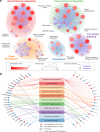De novo variants in congenital diaphragmatic hernia identify MYRF as a new syndrome and reveal genetic overlaps with other developmental disorders
- PMID: 30532227
- PMCID: PMC6301721
- DOI: 10.1371/journal.pgen.1007822
De novo variants in congenital diaphragmatic hernia identify MYRF as a new syndrome and reveal genetic overlaps with other developmental disorders
Abstract
Congenital diaphragmatic hernia (CDH) is a severe birth defect that is often accompanied by other congenital anomalies. Previous exome sequencing studies for CDH have supported a role of de novo damaging variants but did not identify any recurrently mutated genes. To investigate further the genetics of CDH, we analyzed de novo coding variants in 362 proband-parent trios including 271 new trios reported in this study. We identified four unrelated individuals with damaging de novo variants in MYRF (P = 5.3x10(-8)), including one likely gene-disrupting (LGD) and three deleterious missense (D-mis) variants. Eight additional individuals with de novo LGD or missense variants were identified from our other genetic studies or from the literature. Common phenotypes of MYRF de novo variant carriers include CDH, congenital heart disease and genitourinary abnormalities, suggesting that it represents a novel syndrome. MYRF is a membrane associated transcriptional factor highly expressed in developing diaphragm and is depleted of LGD variants in the general population. All de novo missense variants aggregated in two functional protein domains. Analyzing the transcriptome of patient-derived diaphragm fibroblast cells suggest that disease associated variants abolish the transcription factor activity. Furthermore, we showed that the remaining genes with damaging variants in CDH significantly overlap with genes implicated in other developmental disorders. Gene expression patterns and patient phenotypes support pleiotropic effects of damaging variants in these genes on CDH and other developmental disorders. Finally, functional enrichment analysis implicates the disruption of regulation of gene expression, kinase activities, intra-cellular signaling, and cytoskeleton organization as pathogenic mechanisms in CDH.
Conflict of interest statement
The authors have declared that no competing interests exist.
Figures




References
-
- Pober BR, Russell MK, Ackerman KG. Congenital Diaphragmatic Hernia Overview In: Pagon RA, Adam MP, Ardinger HH, Wallace SE, Amemiya A, Bean LJH, et al., editors. GeneReviews(R) Seattle (WA)2010. - PubMed
-
- Stoll C, Alembik Y, Dott B, Roth MP. Associated malformations in cases with congenital diaphragmatic hernia. Genet Couns. 2008;19(3):331–9. Epub 2008/11/11. . - PubMed
Publication types
MeSH terms
Substances
Grants and funding
LinkOut - more resources
Full Text Sources
Molecular Biology Databases
Miscellaneous

